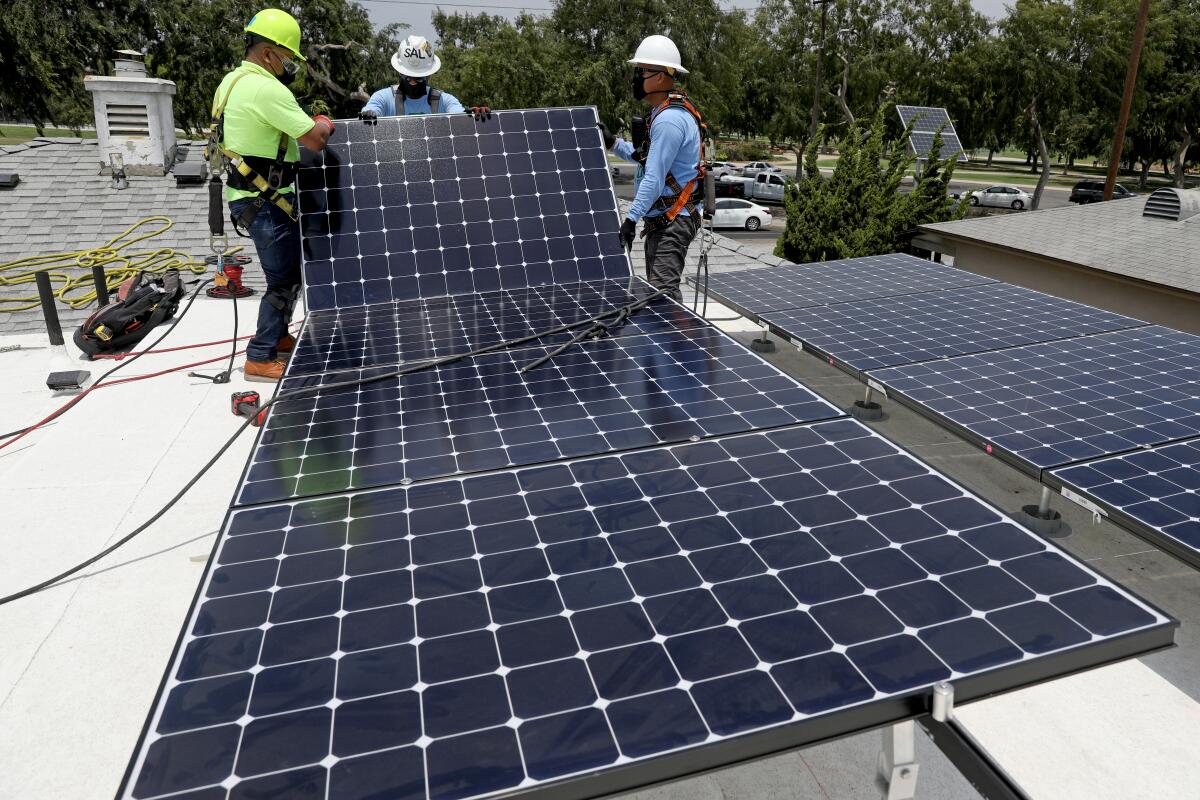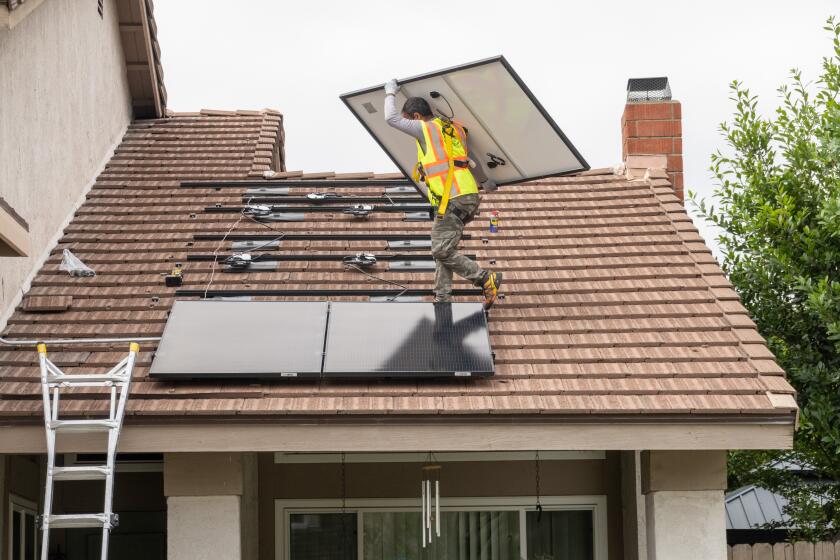Here is one way California can end its rooftop solar wars

- Share via
California needs to accelerate rooftop solar deployment, not constrain it. Yet the California Public Utilities Commission cut solar incentives for homes and businesses drastically in April 2023.
The CPUC’s actions have caused rooftop solar installations to crater, hampering the state’s climate progress. Since April, installations have dropped by about 80% and an estimated 17,000 installers have lost their jobs. Because California has long been a leader in rooftop solar policy, the commission’s decisions may be imperiling rooftop solar elsewhere: Last month, Hawaii instituted similar cuts to its incentives.
The CPUC argued the new rules would give Californians more incentive to install batteries alongside their solar panels by making energy stored in batteries more valuable than energy exported to the grid. But in November the commission also cut incentives for solar-and-battery systems on apartments, schools, strip malls, small businesses and farms.
State regulators gutted the incentive programs for rooftop solar earlier this year. And now, as feared, the solar industry is contracting. This is the opposite of what we need to fight climate change.
Rooftop solar advocates fear the commission is trying to crush distributed solar in favor of corporate installations in California’s deserts and farmlands. The more charitable interpretation is that it is genuinely trying to reform a system in which people who can’t afford solar end up subsidizing wealthier Californians’ installations. These conflicting interpretations have already sparked lawsuits, and they promise to create more political backlash in the coming months. Rather than choosing between equity and rooftop solar, California needs a win-win proposition that prioritizes both.
Over the last two decades, California has proved that rooftop solar can accelerate the energy transition away from fossil fuels, make neighborhoods more resilient by providing local power in case of blackouts and protect residents from extreme heat by lowering building temperatures under solar panels.
Without incentives, though, it doesn’t make financial sense for most Californians to install rooftop solar, meaning we all get less of this badly needed common good. Instead of forcing private utilities to shoulder the costs of incentives, which they then pass through to rich and poor ratepayers alike, California itself should accept the responsibility of supporting rooftop solar.
I can almost hear the screams about high taxes, but hear me out. If we shift support for rooftop solar from utility bills to the tax base, Californians can save on their utility bills by as much as the state pays in incentives.
Gov. Gavin Newsom needs to step up and start defending a crucial climate solution.
The problem of equity has long dogged California’s groundbreaking rooftop solar program. Before last April, the CPUC required utilities to subsidize rooftop solar by paying owners the retail rate for electricity they sent to the grid (typically around 33 cents per kilowatt-hour, but sometimes as much as 75 cents). That’s far higher than the wholesale price that utilities pay to big solar installations (closer to 5 cents).
These higher payments caused utilities’ costs to rise, leading to higher electric rates for all customers, including those without solar panels. As utility rates rose and solar incentives stayed the same, installing rooftop solar — if you could afford it — became more appealing, fueling this unfair cycle.
Even after the CPUC reduced the incentives, utilities are still paying more than wholesale for rooftop solar power. But the reduction has limited the growth of clean energy, undermining California’s decarbonization. To resolve this conflict, we need to both allow utilities to pay competitive rates for electricity, no matter the source, and restore incentives for rooftop solar.
America needs lots of clean power, fast. Should it go on public lands or on rooftops?
Rooftop solar owners should be paid the wholesale rate by the utilities for the excess solar power they send back to the grid. Then, the state should provide sufficient tax credits to the owners for that power to make up the difference between the wholesale price the utility pays and the former incentive price. Funding common goods is one of the core purposes of our state budget, and it’s time to include rooftop solar in that category.
In California, our state income tax is progressive: Those who earn more pay a higher percentage of their income for the public benefit. Electric utility bills, by contrast, are regressive: Those who can’t afford rooftop solar pay a larger share of their income for their basic necessities. We need to restore financial support for rooftop solar — but let’s do so equitably, through our progressive tax code, and redistribute the costs of clean energy away from California’s most vulnerable residents.
Proposing that the state shoulder another financial commitment will be a tough sell, particularly in a year of big deficits. But the world is running out of time to address climate change, and more rooftop solar will decarbonize our grid faster.
The CPUC’s recent actions are moving California backward. By changing the way rooftop solar incentives are paid, we can regain our climate leadership, restore lost solar jobs and move past the rooftop solar wars toward a more sustainable future for everyone.
David Lappen is an electrical engineer and inventor and serves on a subcommittee of the Santa Monica Commission on Sustainability, Environmental Justice and the Environment.
More to Read
A cure for the common opinion
Get thought-provoking perspectives with our weekly newsletter.
You may occasionally receive promotional content from the Los Angeles Times.












